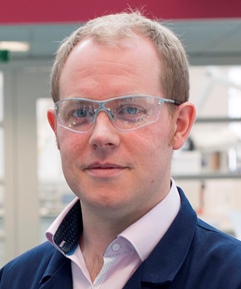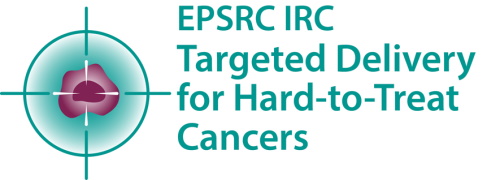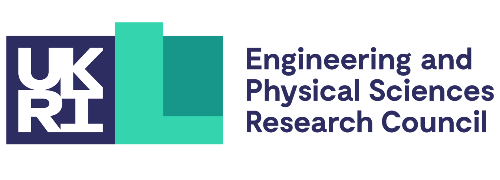Professor Ross Forgan of the University of Glasgow has been part of the IRC since the programme began six years ago. Here, he describes his long-term collaboration with Professor David Fairen-Jimenez at Cambridge, their work on metal-organic frameworks (MOFs) as new drug-delivery vehicles for hard-to-treat cancers, and the enduring impact of the IRC on his research.
“The IRC has a collegial atmosphere. We are open, we discuss things, and it’s always about the science and the mission. It’s this approach that, I believe, will improve outcomes for people with hard-to-treat cancers” Ross Forgan
As Professor of Supramolecular and Materials Chemistry, I’ve been interested in MOFs for many years. Supramolecular chemistry is often described as ‘chemistry beyond the molecule’. It’s a way of thinking about how we can bring different components together to build something larger. In other words, it’s all about design.
MOFs are a class of porous, crystalline materials formed from metal ‘nodes’ and organic molecules or ‘ligands’ which link the metal clusters into 1D, 2D and 3D structures, and scientific interest in MOFs has grown hugely since the 1990s.
By 2024, more than 2,850,000 papers had been published on MOFs, according to Google Scholar. The reason for this lies in their properties: they are strong and porous, have an enormous internal surface area, and are diverse and ‘tuneable’, making them interesting for many potential applications from gas storage to drug delivery.
The overarching aim of the IRC is to find new ways to deliver existing drugs that will improve the outcomes of three hard-to-treat cancers – mesothelioma, glioblastoma and pancreatic cancer. Part of the reason that these three cancers are hard to treat is because they are in parts of the body, or surrounded by particular tissues, that make it hard for drugs to reach them in high enough concentrations to kill the cancer cells.
The first really serious paper on MOFs as drug-delivery vehicles came out around 2010, shortly before I started my career as an independent researcher. It occurred to me early on that my research was relevant, because I’d been preparing nanoparticles and looking for ways to control their size and surface chemistry. And if you want to design a new drug-delivery vehicle, it’s essential that it’s small enough to circulate through the body and its surface chemistry is both biocompatible and stabilises the nanoparticle in water.
Researchers have been looking at both hard, inorganic particles like porous silica and zeolites, as well as small, soft organic systems for drug delivery. The hard, inorganic nanoparticles can be loaded with large cargoes of drug, but compared with organic molecules they are less biocompatible and tend to accumulate in the body because they don’t break down very quickly.
Because they have both organic and inorganic parts, MOFs meet in the middle. Some of them have very significant internal porosities which offer storage capacities you struggle to get with any other system. This means we can put lots of drug into them, making them more efficient. And if you design them properly, with constituents that are biocompatible, then the MOF itself should be biocompatible.
They’re also very chemically tuneable, meaning there are many different combinations of metals or ligands that we can make to tune the structure we want. For example, we can tune the size of the pore to make it the right size for a particular drug. MOFs are chemically quite active, so once we’ve made the MOF, we can continue to functionalise it by, for example, adding things onto its surface. And because you have a huge choice of metals and ligands to make MOFs, you can make MOFs with additional advantageous properties, such as signalling or targeting.
A good example of this is the first MOF to pass phase 1 human trials and move on to phase 2. It’s based on hafnium, which serves as a radiosensitiser. When someone receives radiotherapy, the hafnium absorbs some of the radiation and induces formation of reactive oxygen species locally which help destroy the tumour. In this case, the MOF construct itself is active, so researchers are now looking at combining this property with delivering conventional chemotherapies.
Professor David Fairen-Jimenez at Cambridge and I had both been working on similar challenges for several years before realising we had a shared interest in MOFs. We were both at the University of Edinburgh in 2007 when I was an postgraduate student and he was a research fellow. We were both at Northwestern University in 2011, where I was a postdoc and he was a research associate. But it wasn’t until 2012 when we both won a Royal Society University Research Fellowship that we discovered our shared interest in designing MOFs for drug delivery. We met properly at the induction event, decided to collaborate and have collaborated ever since.
We’ve both been part of the IRC since it began in 2018 and decided to design and test zirconium-based MOFs as drug-delivery vehicles for pancreatic cancer. Some 9,600 cases of pancreatic cancer are diagnosed in the UK every year. It is hard to treat surgically because it is often diagnosed late, and the commonest form, pancreatic ductal adenocarcinoma, is surrounded by rigid fibrotic tissue that makes it hard for drugs to reach the cancer.
From the outset we decided that rather than taking a broad approach, doing lots of exploratory work in many different areas, we wanted to focus on one area and take one or two materials all the way towards translation.
Selecting the best candidates, we’ve studied how good they are at taking up pancreatic cancer drugs and delivering them to the cancer cells. We’ve looked at incorporating things that might enhance their penetration into tumours, and designed new models for this process so that we can take only the strongest candidates into in vivo studies. We’re developing new methods to improve our understanding of how MOFs interact with cancer cells, which is key to delivering effective doses of a drug into a tumour. We’re also looking at ways to take drugs that do not dissolve in water, and so do not circulate well around the body, and load them into MOF vehicles to enhance their uptake by tumours.
Thanks to the IRC, we’ve identified some optimum candidates, ruled out other materials, and introduced some new techniques into the MOF research toolkit. These include real time cell analysis, which allows us to monitor cell growth in real time rather than a single assay to measure proliferation at the end of period of time, and new 3D cell cultures which represent what happens in the body more closely than cells on a well plate.
Lastly, we’ve learned a great deal about MOF biocompatibility in vitro. To be effective for drug delivery, MOFs must be biocompatible. Instead of looking at crude measures of biocompatibility like cell death, we’ve taken a more detailed look at how MOFs affect senescence, which can often lead to cell damage or even cancer.
As well as our results, which we hope will accelerate the use of MOFs in patients, the thing that’s been most valuable to me about the IRC is that it’s brought me into contact with people across the entire spectrum of cancer research. Being able to speak regularly with clinicians who work in the front line against cancer is so important for researchers like me.
The IRC’s interdisciplinary makeup – having access to a broad spectrum of scientists with different backgrounds, viewpoints and drivers – is hugely beneficial. I’ve learned so much from the IRC network, including a lot of information I wouldn’t normally have access to. And it’s informed the way I do research.
MOF drug-delivery research has exploded over the past 10 years, so being part of the IRC network gives me focus. It enables me to look more critically at the literature and gives me a more realistic view of what’s most likely to translate successfully from the lab to the clinic.
This is the real value of the IRC model. Funding and running a six-year, £10m programme is a huge undertaking for the EPSRC and the universities involved. But the value of having this critical mass, bringing people together and engaging with key stakeholders is hard to put a monetary value on. It’s something you don’t get anywhere else.
It’s never hard to find researchers who want to work on cancer because everyone has a personal story. But because the IRC is mission driven, it builds an environment where researchers learn from clinicians and vice versa. The IRC fosters collaboration, and that’s a great model for me because I’m a very open scientist who thrives on collaboration and sharing knowledge. The IRC has a collegial atmosphere. We are open, we discuss things, and it’s always about the science and the mission. It’s this approach that, I believe, will improve outcomes for people with hard-to-treat cancers.



